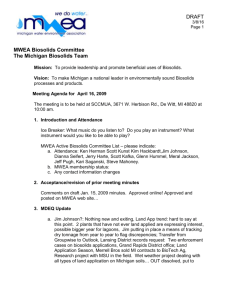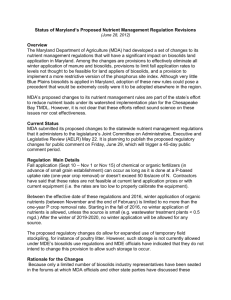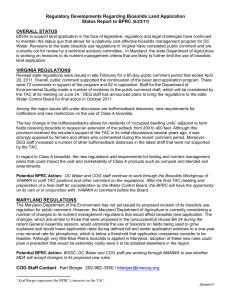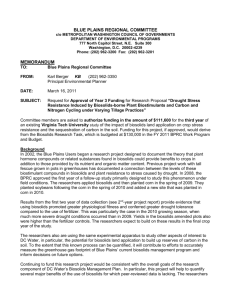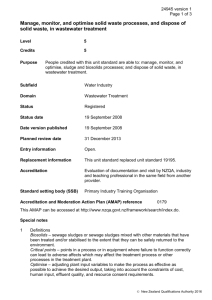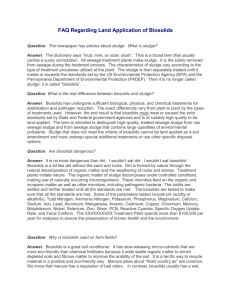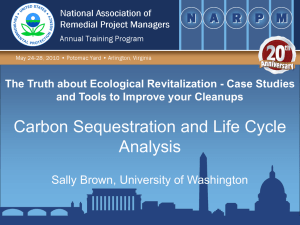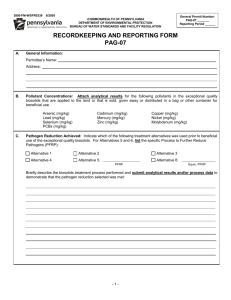Saving Soil: Biosolids Recycling in New England
advertisement
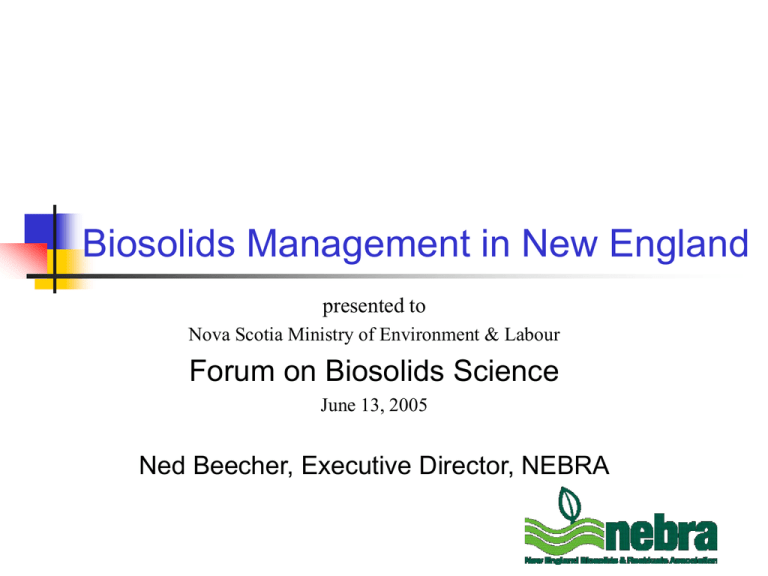
Biosolids Management in New England presented to Nova Scotia Ministry of Environment & Labour Forum on Biosolids Science June 13, 2005 Ned Beecher, Executive Director, NEBRA bi s lids… biosolid n. (1990): solid organic matter recovered from a sewage treatment process and used especially as fertilizer -usually used in plural --Merriam-Webster’s Collegiate Dictionary, 10th Ed. biosolids: plural noun: organic matter recycled from sewage, especially for use in agriculture --New Oxford Dictionary of English, 1998 Outline of presentation Biosolids management & trends Examples of current operations & uses U. S. New England Class B: farm uses (lime treated, anaerobic) Class B: land reclamation (lime treated, anaerobic) Class A: bulk advanced alkaline treatments Class A: heat dried pellets Class A: compost Issues & challenges Biosolids management & trends… United States… About 16,000 wastewater treatment facilities. Produced ~ 6.9 million tons in 1998 (EPA, 1999) ~ 60% applied to land in 1998 (EPA, 1999) Estimated 7.1 million tons in 2005, 66% to land? Majority is Class B land applied, but trend is to more Class A Public scrutiny and concern increasing some Improving products & practices History of U. S. Federal Regulations - “Part 503” Clean Water Act Section 405 – risk-based limits for pollutants “which may adversely affect public health and the environment” Round One (final rule 2/93) – pollutants for which information initially available; screened 350+ pollutants Developed with input from researchers around the country Self-implementing Several management requirements Similar pathogen & vector attraction-reduction as before (Part 257) Pollutant limits based on risk assessment (metals, chemicals) Land application: limits for 9 metals Surface disposal: limits for 3 metals Incineration: limits for 7 metals and total hydrocarbons 1996 review by National Academy of Sciences: “negligible risk” Case for Caution by Harrison et al. (1999), plus other critiques How safe to be? Risk assessment vs. precautionary History of U. S. Federal Regulations (cont’d) Part 503 round 2 – additional pollutants (31) examined based on new information available Dioxins and related compounds targeted 2001 & 2002: dioxin not to be regulated for surface disposal, incineration, and land application Inspector General: EPA does not have information to determine if human health & environment are protected 2002 review by National Academy of Sciences: no document harm, but persistent uncertainties and need for updated science Research proceeding (WERF, EPA bioaerosols, Sustainable Land Application conference (JEQ) Biosolids management & trends… New England Data (2000) Most U. S. states have own, more stringent regulations About 600 publicly owned wastewater treatment facilities in New England Produce approximately 434,000 dry tons of sewage sludge. 96,000 dry tons (22%) of regional sewage sludge is recycled as biosolids fertilizer & soil amendment products About 18% was treated to Class B standards; 82% treated to Class A New England more densely populated, less agriculture (from Saving Soil: Biosolids Recycling in New England, a 2001 NEBRA report from www.nebiosolids.org) New England Data (cont’d) Estimated 3.7 million lbs (est.) nitrogen from 96,000 dry tons recycled biosolids in 2000. Equivalent chemical fertilizer nitrogen would have cost an estimated $1.3 million in 2000 (more now, as N fertilizer prices are up). 96,000 dry tons of biosolids would have required 350,000 cubic yards (est.) of landfill space – equivalent of 6 landfills each the size of a football field & 33 feet deep! New England Data (2000, VT 1999)... New England Biosolids Recycling Rates (2000 data) ME – 77% (treated for beneficial use in agriculture & general landscaping); Class B declining VT – 75% (primarily through composting, much of this in Quebec) NH – 30% (down from 50% in 1996 mainly due to stricter state & local land application regulations) MA – 20% (almost all Class A material including Boston’s MWRA heat dried “Bay State Fertilizer”); this has increased since 2002 with Greater Lawrence heat dried CT & RI – each below 10%, composted Compost markets are strong & growing Maine (2004 data, ME DEP) Tot. cu.yds.compost OR NViro: 93,622 (72,693 cu. meters) Tot. cu.yds. stockpiled: 2,618 (2,033 cu. meters) Tot. cu.yds. landfill: 32,989 (25,614 cu. meters) Tot. cu.yds. out-of-state: 18,114 (14,065 cu. meters) Tot. cu.yds. other use: 0 TOTAL ALL: 168,824 cu. yds (131,084 cu. meters) ~30,000 dry tons (~27,000 metric tonnes) Diverse Biosolids Uses Spectacle Island, Harbor Islands National Park, Boston Harbor Photos : New England Organics, Inc. Bulk / Class B programs... • 2001: Nashua changes from disposal at landfill to recycling, with new anaerobic digester • The digester complex generates electricity, reduces amount and odors of biosolids, and saves ratepayers about $750,000 a year in operating costs. • Class B biosolids used on farms • Boston also uses egg-shaped digesters and recovers energy Bulk Class A & B, lime-treated, Concord, NH biosolids are applied to local fields growing feed corn for dairy cows. Ogunquit, Maine specialized town truck to topdresses Ogunquit Class B biosolids on nearby farm fields for grass hay. Land Reclamation a two-year-old NH reclaimed gravel pit the “manufactured topsoil” develops a sustainable soil ecosystem a one-year-old NH reclaimed gravel pit Keene, NH Landfill after capping with manufactured topsoil Keene, NH September, 2001 photo Photo: Keene / Resource Management, Inc. (from the First Annual New England Biosolids Parade - www.nebiosolids.org) Class A programs Massachusetts Water Resources Authority Deer Island WWTF Boston Harbor Photo: MWRA Egg-shaped digesters treat the sewage sludge from Boston and 42 other communities before it is heat-dried and pelletized to make a fertilizer product. (from the First Annual New England Biosolids Parade - www.nebiosolids.org) Massachusetts Water Resources Authority and New England Fertilizer Company (NEFCO) Quincy, MA Operations Commenced December, 1991 Biosolids Drying and Pelletizing to Produce a Slow-Release Fertilizer (from the First Annual New England Biosolids Parade - www.nebiosolids.org) Greater Lawrence Sanitary District and New England Fertilizer Company (NEFCO) North Andover, MA Operations Commenced December, 2002 Biosolids Drying and Pelletizing to Produce a Slow-Release Fertilizer (from the First Annual New England Biosolids Parade - www.nebiosolids.org) NEFCO ships to Florida to fertilize orange trees and to the Midwest for fertilizer blending and to Colorado for use on ranches and… ...some MWRA uses right close to home... Castle Island, South Boston The Esplanade along the Charles River is fertilized with Bay State Fertilizer. Photos : MWRA. NViro Soil (Class A alkaline treated) Innovative Earth Solutions / Soil Preparation, Inc. Plymouth, Maine Merrimack, NH biosolids compost Merrimack, New Hampshire Nourishing Green Parks and Fairways The Great Lawn, Central Park NYC New England Golf Course Photos: Merrimack / Agresource Hawk Ridge in Unity, Maine Largest private composting operation in New England More composting... Photo: Agresource. Ipswich, MA Agresource compost operation. Williamstown, MA Composting biosolids produces a Class A biosolids product that can be used anywhere... A Maine outdoor “windrow” biosolids compost operation. LAWPCA Compost Facility Auburn, ME 1988 - present Sited with plenty of space around it, this biosolids compost facility has operated steadily since the late 1980s. Lewiston-Auburn Water Pollution Control Authority Lewiston-Auburn, ME (from the First Annual New England Biosolids Parade - www.nebiosolids.org) GSI Compost Facility Near Sherbrooke, QU September, 2002 Wastewater solids from around northern New England, including all of the Burlington area, is composted in Quebec and made into various soil amendments and products. GSI Environnement Sherbrooke, QU (from the First Annual New England Biosolids Parade - www.nebiosolids.org) More compost uses... Maine’s Colby College uses biosolids compost on sports turf. Photo: New England Organics Photo: Agresource. …sports fields... A Tufts University football field is topdressed with biosolids compost. …and wetlands... This constructed wetland along a NH highway has soil made with biosolids compost. Current issues / concerns Sewage sludge contains more than just human waste; it also contains… “heavy” metals chemicals pathogens (disease-causing microorganisms) mostly in Class B Sewage sludge and biosolids can have odors Political landscape Some political interest at national & state levels EPA Office of Inspector General, National Academy of Sciences reports About 17% of NH towns have severe restrictions. A few Maine and Massachusetts towns too. Attempts nationally and in states for stopping land application have failed (e.g. Center for Food Safety petition to EPA, but state & local regulations have gotten stricter) Responding to concerns... Public concerns are legitimate--people don’t know much about this specialized field and initial negative reactions are natural People need time to absorb new information Some biosolids management programs are getting more sensitive, involving the public more Improving practices National Biosolids Partnership - EMS Current state of the science Large amount of research behind current biosolids management practices & regulations EPA Risk Assessment - 503 Rule (with W-170 input) Several long-term studies: e.g. Pennsylvania land reclamation, Rosemount farm use, Chicago Prairie Plan, King County forests Review by the National Academy of Sciences 1996 Review by the National Academy of Sciences 2002 Every decade “state-of-the-science” conference (last in 2004) BUT there are still going to some questions regarding risks of biosolids management: currently odors/bioaerosols, ecological impacts of trace chemicals (PDBEs, endocrine disruptors) Bottom line (my opinion) On-going scientific research and debate are necessary and should continue, but… …decades of experience and research have led many knowledgeable researchers to conclude that current best biosolids management practices represent relatively low risk to public health and the environment. But it has to be done right and assurance of that is key! Thank you! New England Biosolids and Residuals Association P. O. Box 422 / Tamworth, NH 03886 USA phone 603-323-7654 / info@nebiosolids.org www.nebiosolids.org Cooperatively promoting the environmentally sound recycling of biosolids and other residuals. N.E. Trace Metals Averages Nova Scotia Guidance (May 04) Trace Metals Limits (mg/kg dry weight) Metal Exceptnl Quality Class A / B Compare NH Standard (regular / low metals) Arsenic 13 75 32 / 10 Cadmium 3 20 14 / 10 Chromium 210 1060 1000 / 160 Cobalt 34 150 Not regulated Copper 400 760 1500 / 1000 Mercury 0.8 5 10 / 7 Molybdenum 5 20 35 / 18 Nickel 62 180 200 / 98 Lead 150 500 300 / 270 Selenium 2 14 28 / 18 Zinc 700 1850 2500 / 1780 N.E. trace metals of greatest environmental concern: arsenic (As) Cha rt 3.12 : Average Conc entrations of Arsenic in New England Bios olids 2000 New Hampshire 1999 Maine 1998 Mass ac husetts 1997 Vermont 1996 Federal Standard 1995 1994 0.00 5.00 10.00 15.00 20.00 25.00 30.00 Par ts pe r m illion (m g/k g) 35.00 40.00 45.00 NOTE: Federal U. S. standards shown for comparison are the strictest (EQ) standards. NS guidelines EQ = 13 ppm N.E. trace metals of greatest environmental concern: cadmium (Cd) Cha rt 3.13 : Average Conc entrations of Cadm ium in New England Bios olids 2000 1999 New Hampshire Maine Mass ac husetts Vermont Federal Standard 1998 1997 1996 1995 1994 0 5 10 15 20 25 Par ts pe r m illion (m g/k g) 30 35 40 NOTE: Federal U. S. standards shown for comparison are the strictest (EQ) standards. NS guidelines EQ = 3 ppm. N.E. trace metals of greatest environmental concern: lead (Pb) Chart 3.1 4: Average Concentra tion s of Lea d in New Engl and Bioso lids 2000 1999 New Hampshire Maine Mass ac husetts Vermont Federal Standard 1998 1997 1996 1995 1994 0 50 200 150 100 Par ts pe r m illion (m g/k g) 250 300 NOTE: Federal standards shown for comparison are the strictest (EQ) standards. NS guidelines EQ = 150 ppm. N.E. trace metals of greatest environmental concern: mercury (Hg) Chart 3.1 5: Average Concentra tion s of Mercu ry in New Engl and Bioso lids 2000 1999 New Hampshire Maine Mass ac husetts Vermont Federal Standard 1998 1997 1996 1995 1994 0 3 6 9 Par ts pe r m illion (m g/k g) 12 15 NOTE: Federal standards shown for comparison are the strictest (EQ) standards. NS guidelines EQ = 0.8 ppm. 18 Trace metals in other agricultural materials, for comparison Chart 3.2: Reported Averages (or Ranges) of Trace Metals Levels in Other Materials (ppm or mg/kg) Dairy Ma nure (4) Dairy Ma nure (3) Feedl ot Ma nure (2) Pig Waste (2) Swine Ma nure (3) Poultry Litter (2) Chicken Ma nure (3) Arsenic ( As) 0.26 0.88 NA 3.7 NA 30 0.66 Cadmium (Cd) 0.32 0.03 0.2 ND 0.32 ND 0.59 Chromium ( Cr) 5.2 20 NA 61 NA 20 4.9 Copp er (Cu) 41 11.6 2.0 501 14.3 1195 13 Lead (Pb) 6.6 2.1 0.2 ND 1 12 11.5 Mercury (Hg) 0.09 0.05 NA ND NA NA 0.04 Molybdenum (Mo) 2.5 22.1 NA 7.9 22.6 NA 95.3 Nic kel ( Ni) 7.8 3.3 NA 29.3 NA NA 3.9 Selenium (Se) 0.5 NA 5000 ND NA NA NA Zinc (Zn) 215 21 8 656 60 631 297 Trace Metal Calculating Accumulation of Metals in Soils From a Typical Bulk Biosolids Application Typical chemicals of possible concern Chemical Content of Sludge/Biosolids (from Carpenter, 2000) Sludge is engineered to capture… • organic matter • nutrients (especially nitrogen and phosphorous) Sludge also favors retention of • insoluble compounds • non-, or semi-volatile compounds • non-readily degradable compounds • compounds that are strongly sorbed to organic matter In some cases, the management of wastewater treatment plants may result in sludge containing metabolites of organic matter decomposition In many ways, the chemical quality of sludge is representative of the the chemical quality of our environment Dioxin Concentrations in Biosolids (from Carpenter, 2000) Sampling years Number of samples Mean Median ppt (dry weight) Maine 1995-1997 31 6.3 5.4 New Hampshire 1999/2000 95 5.2 3.5 Vermont 1997 28 11.2 8.6 NSSS 1988 208 831 371 1 Data taken from Jones, K.C. and A.P. Stewart 1996. Dioxins and furans in sewage sludges 2 Non-detects were reported as 1/2 the detection limit when calculating TEQ values Pathogens Public concern, especially emerging pathogens Advances in detection & science A focus of the 2002 National Academy of Sciences review Continued research needed & expected Current treatment technologies likely to treat for emerging pathogens also Most exposed are operators; public much less exposed (although exposures may not be comparable) Be concerned about neighbors - best management needed Ensure proper treatment! Odors/Bioaerosols A common trigger of public concern Current research identifying specific compounds (EPA/USDA) and potential effects Enforcement & Oversight Critical for public confidence Independent oversight / local involvement Reviewing policy… look at scientific summaries. In 1996, the lead U. S. scientific body, the National Academy of Sciences, reviewed biosolids recycling and concluded: “In summary, society produces large volumes of treated municipal wastewater and sewage sludge that must be either disposed of or reused. While no disposal or reuse option can guarantee complete safety, the use of these materials in the production of crops for human consumption, when practiced in accordance with existing federal guidelines and regulations, present negligible risk to the consumer, to crop production, and to the environment.” U. S. National Academy of Sciences 2002 review: “There is no documented scientific evidence that the Part 503 rule has failed to protect public health. However, additional scientific work is needed to reduce persistent uncertainty about the potential for adverse human health effects from exposure to biosolids. There have been anecdotal allegations of disease, and many scientific advances have occurred since the Part 503 rule was promulgated. To assure the public and to protect public health, there is a critical need to update the scientific basis of the rule to (1) ensure that the chemical and pathogen standards are supported by current scientific data and risk-assessment methods, (2) demonstrate effective enforcement of the Part 503 rule, and (3) validate the effectiveness of biosolids management practices.” Thank you! New England Biosolids and Residuals Association P. O. Box 422 / Tamworth, NH 03886 USA phone 603-323-7654 / info@nebiosolids.org www.nebiosolids.org Cooperatively promoting the environmentally sound recycling of biosolids and other residuals.


